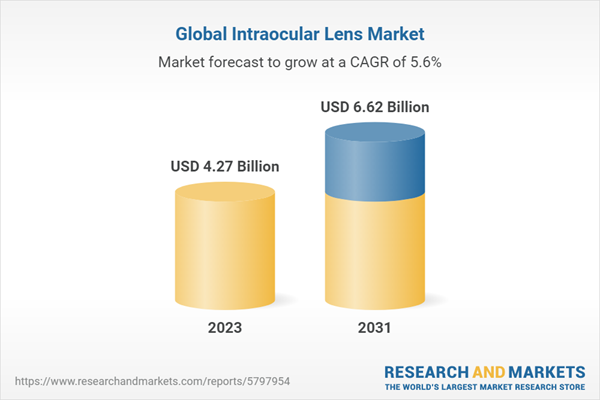The global intraocular lens market value was USD 4.04 billion in 2022, driven by increasing prevalence of cataracts and other eye-related disorders across the globe. The market size is anticipated to grow at a CAGR of 5.6% during the forecast period of 2023-2031 to achieve a value of USD 6.62 billion by 2031.
North America: The largest market for IOLs, driven by factors such as an advanced healthcare infrastructure, a growing aging population, and high adoption rates of advanced IOL technologies.
Europe: The second-largest market, with increasing demand for IOLs due to a growing elderly population, a supportive regulatory framework, and an expanding healthcare sector.
Asia Pacific: Expected to witness the highest growth rate due to factors such as a rapidly growing population, increasing prevalence of cataracts, and growing investments in healthcare infrastructure and research.
Intraocular Lens: Introduction
Intraocular lenses (IOLs) are small, artificial lenses implanted in the eye to replace the eye's natural lens during cataract surgery or refractive lens exchange. Cataracts occur when the eye's natural lens becomes clouded or opaque, leading to vision impairment. IOLs are designed to restore clear vision and reduce dependence on eyeglasses or contact lenses. They are made from various materials, including acrylic, silicone, and polymethyl methacrylate (PMMA), and are available in various designs, such as monogonal, multifocal, and toric lenses, each addressing specific vision requirements.Intraocular Lens Market Scenario
The global intraocular lens market is experiencing significant growth due to factors such as an aging population, technological advancements in IOL materials and designs, and the increasing prevalence of cataracts and other eye-related disorders. As the global population ages, the demand for IOLs is expected to rise, with more people requiring cataract surgery or refractive lens exchange. Innovations in IOL technology, such as extended depth of focus (EDOF) lenses and adjustable IOLs, have improved patient outcomes and increased the demand for IOLs. Moreover, the growing awareness of the importance of eye health and the availability of advanced treatment options contribute to the market's expansion.North America: The largest market for IOLs, driven by factors such as an advanced healthcare infrastructure, a growing aging population, and high adoption rates of advanced IOL technologies.
Europe: The second-largest market, with increasing demand for IOLs due to a growing elderly population, a supportive regulatory framework, and an expanding healthcare sector.
Asia Pacific: Expected to witness the highest growth rate due to factors such as a rapidly growing population, increasing prevalence of cataracts, and growing investments in healthcare infrastructure and research.
Intraocular Lens Market Segmentations
Market Breakup by Product
- Monofocal
- Multifocal
- Toric
- Accommodative
- Others
Market Breakup by End User
- Hospitals
- Ophthalmic Clinics
- Ambulatory Surgery Centers
- Eye Research Institute
- Others
Market Breakup by Region
North America
- United States of America
- Canada
Europe
- United Kingdom
- Germany
- France
- Italy
- Others
Asia Pacific
- China
- Japan
- India
- ASEAN
- Australia
- Others
Latin America
- Brazil
- Argentina
- Mexico
- Others
Middle East and Africa
- Saudi Arabia
- United Arab Emirates
- Nigeria
- South Africa
- Others
Key Trends in the Intraocular Lens Market
Some key trends of the market are as follows:- Growing aging population: As the global population ages, the prevalence of cataracts and the demand for IOLs are expected to increase
- Technological advancements: Innovations in IOL materials and designs, such as extended depth of focus (EDOF) lenses and adjustable IOLs, have improved patient outcomes and increased the demand for IOLs
- Increasing prevalence of cataracts and other eye-related disorders: A growing number of individuals are being affected by cataracts and other vision-related issues, leading to a rising demand for IOLs and cataract surgeries
Intraocular Lens Market: Competitor Landscape
The key features of the market report include patent analysis, grants analysis, clinical trials analysis, funding and investment analysis, partnerships, and collaborations analysis by the leading key players. The major companies in the market are as follows:- Johnson and Johnson Vision Care, Inc
- Bausch & Lomb Incorporated
- Carl Zeiss Meditec AG
- EyeKon Medical, Inc
- HumanOptics AG
- HOYA CORPORATION
- STAAR Surgical Company
- Lenstec, Inc
- Rayner
Table of Contents
1 Preface
3 Global Intraocular Lens Market Overview
4 Global Intraocular Lens Market Landscape
5 Global Intraocular Lens Market Dynamics
6 Global Intraocular Lens Market Segmentation
7 North America Intraocular Lens Market
8 Europe Intraocular Lens Market
9 Asia Pacific Intraocular Lens Market
10 Latin America Intraocular Lens Market
11 Middle East and Africa Intraocular Lens Market
12 Patent Analysis
13 Grants Analysis
14 Funding Analysis
15 Partnership and Collaborations Analysis
16 Regulatory Framework
17 Supplier Landscape
18 Global Intraocular Lens Market- Distribution Model (Additional Insight)
20 Company Competitiveness Analysis (Additional Insight)
21 Payment Methods (Additional Insight)
Companies Mentioned
- Johnson and Johnson Vision Care, Inc.
- Bausch & Lomb Incorporated
- Carl Zeiss Meditec AG
- Eyekon Medical, Inc.
- Humanoptics AG
- Hoya Corporation
- Staar Surgical Company
- Lenstec, Inc.
- Rayner
Methodology

LOADING...
Table Information
| Report Attribute | Details |
|---|---|
| No. of Pages | 147 |
| Published | May 2023 |
| Forecast Period | 2023 - 2031 |
| Estimated Market Value ( USD | $ 4.27 Billion |
| Forecasted Market Value ( USD | $ 6.62 Billion |
| Compound Annual Growth Rate | 5.6% |
| Regions Covered | Global |
| No. of Companies Mentioned | 9 |









